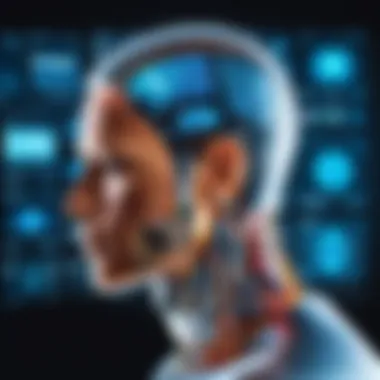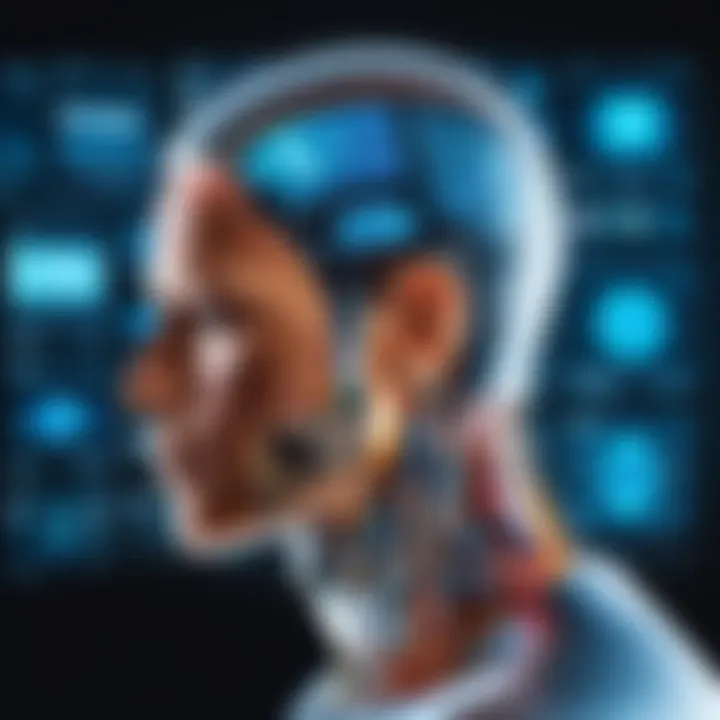DICOM Image Software: A Comprehensive Overview


Intro
DICOM image software plays a vital role in the medical imaging landscape. It ensures that images from various modalities are standardized and accessible for health care professionals. This article serves as a comprehensive overview of the DICOM ecosystem, touching on aspects such as its standards, functionality, integration with other systems, and security concerns.
By delving into DICOM software, IT professionals, medical practitioners, and technology enthusiasts can gain insight into its critical influence on modern healthcare. A solid foundation in DICOM standards is necessary to understand how imaging software operates and interacts with other medical technologies.
Understanding Storage, Security, or Networking Concepts
Intro to the basics of storage, security, or networking
In the context of DICOM software, understanding how storage and security work is essential. Storage deals with how medical images are kept and retrieved, while security ensures the integrity and confidentiality of these sensitive files. Networking plays a crucial role in how images are shared across systems, making it imperative to grasp these intertwined concepts.
Key terminology and definitions in the field
- DICOM: Digital Imaging and Communications in Medicine, a standard for handling and transmitting medical images.
- PACS: Picture Archiving and Communication System, a system used to store and access DICOM images.
- HL7: Health Level 7, a set of international standards for the transfer of clinical and administrative data between software applications.
Overview of important concepts and technologies
DICOM files can be quite large and require efficient storage solutions. Storage technologies such as cloud storage or localized servers are becoming more common due to their flexibility. Security measures involve encryption and user authentication to protect data. Networking technologies ensure that images can be shared swiftly between departments or hospitals, using protocols like TCP/IP to maintain communication.
Best Practices and Tips for Storage, Security, or Networking
Tips for optimizing storage solutions
- Use RAID configurations to protect against data loss.
- Implement tiered storage for cost-effective resource use; keep frequently accessed files on faster storage.
- Regular backups are necessary to ensure data is not lost during unforeseen events.
Security best practices and measures
- Encryption is vital for securing sensitive DICOM files, both at rest and in transit.
- Access controls should be established to limit who can view or modify images.
- Regular audits can help detect vulnerabilities or breaches in your system.
Networking strategies for improved performance
- Utilize high-speed connections to facilitate rapid image transfer.
- Network segmentation can help isolate sensitive data and enhance security.
- Employ load balancing to distribute requests evenly across servers, minimizing delays.
Industry Trends and Updates
Latest trends in storage technologies
The rise of cloud computing has introduced more scalable storage solutions, allowing healthcare facilities to manage large volumes of DICOM images without investing heavily in physical infrastructure. Many organizations are transitioning to cloud storage for its flexibility and cost-effectiveness.
Cybersecurity threats and solutions
With increased digital records, threats such as ransomware and data breaches pose risks to healthcare data. It's crucial for organizations to adopt advanced cybersecurity measures like threat detection systems and employee training programs to counter these threats.
Networking innovations and developments
Recent advances in networking technologies provide hospitals with faster data-processing abilities. Technologies like 5G and SD-WAN can significantly improve the speed and reliability of DICOM image transfers, enhancing the overall efficiency of healthcare services.
Case Studies and Success Stories
Real-life examples of successful storage implementations
Several hospitals have transitioned to cloud-based PACS solutions, allowing them to access images remotely while reducing the need for physical storage space. These implementations have seen increased staff productivity and streamlined patient care.
Cybersecurity incidents and lessons learned
In 2021, a major hospital faced a ransomware attack that compromised patient data. The incident prompted a reevaluation of their security protocols, leading to better practices, including employee training and enhanced system vulnerabilities assessments.
Networking case studies showcasing effective strategies
A regional health system successfully implemented SD-WAN technology, which resulted in up to a 40% increase in the speed of DICOM image transfers between clinics and hospitals, showcasing the benefits of modern networking solutions in healthcare.
Reviews and Comparison of Tools and Products
In-depth reviews of storage software and hardware
Some leading storage solutions like NetApp and Dell EMC provide robust options tailored for healthcare environments. They offer features that include high availability, scalability, and security compliance, making them suitable for handling DICOM images.


Comparison of cybersecurity tools and solutions
McAfee and Symantec offer comprehensive cybersecurity solutions that cater to healthcare facilities. Their features include advanced threat detection, compliance monitoring, and incident response capabilities tailored to protect sensitive health information.
Evaluation of networking equipment and services
Companies like Cisco and Arista Networks provide cutting-edge networking equipment that ensures reliable and efficient data transfer for healthcare organizations, especially where timely access to DICOM images is crucial for patient care.
Understanding the sophisticated landscape of DICOM image software is more crucial than ever, shaping the future of medical imaging and patient care.
Preamble to DICOM Imaging
DICOM imaging is a vital component in the field of medical imaging. This section serves as a foundation for understanding both the technical and practical aspects of Digital Imaging and Communications in Medicine (DICOM). The advancements in medical imaging technologies have made DICOM standards essential for ensuring that images and related information can be shared seamlessly across various healthcare systems.
Understanding DICOM
DICOM is not just a file format; it is a comprehensive standard that manages medical data. It defines how images are stored, transmitted, and presented. Each DICOM file contains not only the image but also metadata, detailing patient information, imaging technique, and settings used during acquisition. This structured format allows for interoperability among devices and software, which is crucial for effective communication in healthcare environments.
The implementation of DICOM is prevalent in radiology, cardiology, dermatology, and many other specialties. Understanding DICOM affects how healthcare professionals handle and retrieve medical images, enhancing workflow and reducing miscommunication during diagnosis and treatment.
The Importance of DICOM Standards
The DICOM standards play a pivotal role in the healthcare industry. They ensure consistency and reliability in medical imaging. This is particularly important in multi-disciplinary teams where various departments may need to access the same imaging datasets.
Key benefits of DICOM standards include:
- Interoperability: Medical devices and software from different manufacturers can communicate effectively, which enhances patient care.
- Data Integrity: DICOM ensures that the integrity of the images and associated data is preserved during transmission.
- Global Adoption: The widespread acceptance of DICOM as a universal standard facilitates international collaboration in research and clinical practices.
DICOM standards shape the future of medical imaging by supporting innovations in how images are created, shared, and utilized.
Technical Specifications of DICOM Software
Understanding the technical specifications of DICOM software is crucial for ensuring optimal functionality and performance in medical imaging. The DICOM standard, which stands for Digital Imaging and Communications in Medicine, facilitates the sharing and management of medical images across various platforms. This section delves into two key aspects: data formats and protocols, and software architecture. Each element plays a vital role in how DICOM software operates within healthcare systems and impacts the overall efficiency of medical imaging workflows.
Data Formats and Protocols
DICOM utilizes specific data formats and protocols that allow for standardized communication and exchange of medical images. The DICOM file format encompasses both image data and associated metadata, ensuring that important information is transmitted alongside the image itself. This format includes various types of imaging modalities, such as CT, MRI, and Ultrasound.
Furthermore, DICOM defines several protocols that standardize how devices communicate with one another. For instance, the DICOM networking protocols allow different devices, such as imaging machines and workstations, to transmit images securely and reliably.
The importance of adhering to these formats and protocols cannot be overstated. Benefits include:
- Interoperability: Ensures that images can be shared across different systems without compatibility issues.
- Data Integrity: Protects the completeness and accuracy of images and metadata during transmission.
- Efficiency: Facilitates faster processing and retrieval of images in clinical settings.
In summary, understanding DICOM data formats and protocols is essential for IT professionals and healthcare providers alike to create seamless workflows.
Software Architecture
The architecture of DICOM software comprises several layers that work together to facilitate image processing. At its core, the architecture generally includes components such as data management, user interface, image processing, storage management, and communication interface.
- Data Management: This layer encompasses the storage and retrieval of DICOM files. Efficient data management ensures quick access to images, which is critical in time-sensitive medical environments.
- User Interface: An intuitive user interface is important for healthcare professionals who need to navigate quickly through images and annotations. A user-friendly design enhances productivity and minimizes errors.
- Image Processing: This component performs necessary modifications and analysis on the images. Advanced processing algorithms can enhance image quality, making it easier for medical personnel to diagnose and analyze.
- Storage Management: This layer handles where and how images are stored, utilizing systems like PACS (Picture Archiving and Communication Systems). Proper storage solutions ensure that images are readily available and securely archived.
- Communication Interface: This particularly directs the interaction with other systems and devices. It is crucial for ensuring that images from different sources can be integrated smoothly.
By understanding the intricate details of software architecture, IT professionals can make informed decisions about system implementations and optimizations. This knowledge allows for better alignment of DICOM software capabilities with the specific needs of healthcare facilities.
The technical specifications of DICOM software serve as the backbone for effective medical imaging solutions, enabling advanced functionality and efficient workflows.
Popular DICOM Image Software Solutions
DICOM image software solutions play a crucial role in the management and analysis of medical imaging. With the increasing complexity and volume of medical images, selecting the right software becomes essential for healthcare professionals. These solutions streamline workflows, enhance image quality, and facilitate collaboration among different specialties. This section delves into notable DICOM software options available today, providing insights into their features and capabilities.
Overview of Leading Software
Many software solutions are designed to cater to the specific needs of medical imaging. Some of the prominent options include:
- RadiAnt DICOM Viewer: This is a lightweight software known for its user-friendly interface and robust performance. It offers efficient navigation through large datasets, making it suitable for radiologists.
- OsiriX: A renowned choice for Mac users, OsiriX provides advanced visualization tools and supports multiple imaging modalities. Its ability to handle 3D reconstruction is particularly beneficial for specialists.
- Ginkgo CADx: Ginkgo is open-source software that stands out due to its flexibility. It is extensible, allowing users to add plugins as per their requirements, making it adaptable to various clinical settings.
- MicroDicom: This is a free DICOM viewer that offers a variety of features including tools for measurement and image enhancement. It is ideal for users starting in radiology or needing basic functionalities.
- InteleViewer: Mainly used in enterprise environments, InteleViewer integrates seamlessly with PACS systems and enhances productivity through its collaborative features. It emphasizes security and compliance, which is often critical in larger healthcare facilities.
Each software comes with its distinct advantages, catering to different user needs and institutional requirements. Additionally, understanding the specific environments in which these software solutions operate is important. The right choice can significantly affect workflow efficiency and image diagnostics.


Comparison of Features
When choosing a DICOM image software solution, understanding the features is key. Here are some essential elements to consider:
- User Interface: A clean and intuitive user interface reduces the learning curve for new users. Software like RadiAnt and OsiriX excel in this area, providing easy navigation and manual options.
- Support for Multiple Formats: The ability to handle various image formats, such as MRI, CT, and PET scans, is critical. Most leading software solutions support multiple modalities, although the extent may vary.
- Image Processing Tools: Advanced image processing features such as 3D reconstruction, measurements, and filters improve diagnostic capabilities. OsiriX and Ginkgo CADx are examples of software that offer robust processing tools.
- Integration Capabilities: Software that allows for easy integration with existing systems like Electronic Health Records (EHR) and PACS can streamline workflows and improve productivity. InteleViewer is a leader in this respect due to its strong integration with various healthcare infrastructures.
- Cost: Cost considerations also play a significant role for institutions. While some options like RadiAnt come with a price, others like Ginkgo CADx being open-source, can be more budget-friendly.
- Security Features: With increasing cyber threats, robust security measures are non-negotiable for healthcare applications. Identifying software with advanced security protocols is essential, particularly for enterprise-level applications.
In a landscape filled with choices, understanding these features helps in aligning software selections with the specific needs of healthcare providers. By analyzing both the offerings and capabilities of these leading solutions, practitioners can better serve their patients and enhance diagnostic accuracy.
Applications of DICOM Image Software in Healthcare
The use of DICOM image software in healthcare is pivotal. This software not only supports efficient storage and management of medical images but also enhances the overall workflow of image processing and analysis. By ensuring that medical imaging adheres to DICOM standards, these tools help bridge the gap between different imaging modalities. The ability to exchange and retrieve data seamlessly among various systems helps in improving patient outcomes.
This section will explore two major areas where DICOM image software proves essential: radiology and pathology. Each section will outline specific benefits and considerations associated with these applications.
Radiology and Imaging
Radiology relies heavily on DICOM image software for a variety of functions. Workstation compatibility is one key advantage. Radiologists use software like OsiriX and RadiAnt DICOM Viewer to efficiently view and analyze images from CT scans, MRIs, and other imaging modalities. These software applications provide a user-friendly interface and support advanced image manipulation techniques, which can be crucial for accurate diagnoses.
Another important factor is image archiving and retrieval. DICOM-compatible systems facilitate the storage of large volumes of imaging data with ease. Patients often return for follow-ups, and having a robust archive allows for quicker access to previous images. This enhances the radiologist's ability to make informed decisions based on historical imaging data, contributing to better diagnostic accuracy.
"The integration of DICOM imaging software has revolutionized how radiologists access and analyze images, ultimately improving patient care."
Moreover, many modern DICOM solutions include automated reporting features, which save time and reduce the risk of human error. Annotations and the ability to compare previous results enable radiologists to accurately track changes over time. All of this significantly improves the management of imaging resources within a healthcare facility.
Pathology and Other Specialties
In the realm of pathology, DICOM image software has similar significance. Pathologists increasingly use digital pathology platforms such as Aperio and Nuance to process and analyze biopsy samples. These tools not only simplify the workflow but also enable remote consultations.
One major benefit here is the enhanced collaboration among pathologists. By using DICOM standards, images can be shared easily with colleagues for second opinions or joint analyses. This collaborative approach improves diagnostic accuracy and fosters knowledge sharing among specialists.
Furthermore, in pathology, data integration becomes crucial. DICOM software solutions often now allow for direct comparison between histopathology images and radiology images. This integrated view provides a more comprehensive understanding of the patient’s condition and facilitates more precise treatment plans.
Lastly, the automation of routine tasks through advanced DICOM systems enhances productivity. This allows pathologists to focus on more complex cases that require higher levels of expertise.
Overall, the strategic application of DICOM image software in both radiology and pathology underlines its vital role in modern healthcare. As medical practices continue to evolve, the integration of these systems will keep enhancing patient care and operational efficiency.
Integration with Healthcare Systems
In the realm of medical imaging, integration with healthcare systems is essential. DICOM software plays a pivotal role in connecting diverse systems within healthcare infrastructures. The aim is to create a seamless flow of information, improve workflow efficiency, and enhance patient care outcomes. This integration facilitates various functionalities crucial for modern healthcare operations.
DICOM imaging systems are commonly integrated with Electronic Health Records (EHR) and Picture Archiving and Communication Systems (PACS). The interconnectivity of these systems allows for more comprehensive patient information management. Here are some key benefits of integration with healthcare systems:
- Enhanced Data Access: Medical professionals can access DICOM images alongside patient records, allowing for better diagnostic accuracy.
- Streamlined Workflow: Integration reduces the time spent on accessing disparate systems. This lets healthcare providers focus more on patient care instead of administrative tasks.
- Improved Communication: It enables better collaboration among healthcare providers, ensuring that everyone involved in a patient's care is on the same page.
- Regulatory Compliance: Adopting integrated systems helps meet various compliance requirements related to health data management.
- Cost Effectiveness: A well-integrated system can reduce costs associated with duplicated efforts and increase operational efficiency.
These points highlight the importance of integrating DICOM image software with broader healthcare systems. It sets the stage for maximizing the potential of medical imaging technologies.
Electronic Health Records (EHR)
The integration of DICOM software with Electronic Health Records (EHR) is transformative. EHRs aggregate patient data into a single digital format. This includes demographic information, medical history, medications, and test results. When DICOM images are incorporated into EHRs, it creates a complete patient profile.
One of the most significant advantages is the availability of imaging studies directly within the patient's EHR. With DICOM data linked to EHR, healthcare providers can:
- Monitor Patient Progress: Providers can visualize changes over time, aiding in treatment effectiveness assessments.
- Streamline Workflow: Automatic patient data updates save time and reduce the risk of errors in data entry.
- Facilitate Research and Analytics: Access to comprehensive datasets supports clinical research and improves decision-making.
Although there are benefits, challenges exist in EHR integration. Interoperability concerns can arise due to variations in DICOM standards. Addressing these issues is critical for smooth data exchange and effective usage of the integrated system.
PACS and Other Imaging Systems
Integrating DICOM software with PACS and other imaging systems is crucial for cohesive healthcare delivery. PACS stores, retrieves, and displays images. It provides healthcare professionals with immediate access to imaging studies, which is essential in high-stakes environments like radiology.
The integration brings several advantages:
- Centralized Image Management: A unified system allows for easier tracking of patient images and reports. This reduces the risk of misplacement.
- Improved Diagnostic Accuracy: Immediate access to DICOM images fosters timely and accurate diagnoses, ultimately leading to better patient outcomes.
- Collaboration Across Disciplines: Facilitates collaboration between different specialties that rely on imaging technologies, enhancing interdisciplinary care.
- Reduction in Manual Processes: Automating image sharing decreases the manual work needed to distribute images, thus increasing efficiency.
While there are many benefits to integrating DICOM with PACS, it also comes with challenges. For instance, compatibility issues may create obstacles. Solving these problems is necessary to ensure a functional and productive integration of systems.
Challenges in DICOM Software Usage


DICOM software serves a critical function in medical imaging, yet several challenges hinder its full potential. Understanding these challenges is essential for IT professionals and healthcare providers. Addressing issues such as data security, interoperability, and user training is necessary for optimizing system performance and maintaining compliance with regulations.
Data Security and Privacy
Data security and privacy are paramount in any healthcare system. DICOM software often handles sensitive patient information. Thus, ensuring that this data is protected is not just best practice; it is a legal requirement under regulations such as HIPAA in the United States.
The importance of securing DICOM images lies in the trust that patients place in healthcare providers. Breaches can lead to severe consequences, including financial penalties and loss of credibility.
To mitigate risks:
- Encryption: Use encryption protocols for data transmission and storage.
- Access Control: Implement strict user authentication to restrict who can view or modify sensitive data.
- Training: Educate users on data protection practices and the importance of patient confidentiality.
Keeping DICOM software updated is also crucial in combating emerging threats. Regularly patching systems can close vulnerabilities that hackers might exploit. The evolving nature of cyber threats means that security strategies must adapt continually.
"Investing in strong cybersecurity measures is not optional; it is essential."
Interoperability Issues
Interoperability refers to the ability of different systems to work together seamlessly. In a healthcare environment, DICOM software often needs to connect with various systems, including Electronic Health Records (EHR) and Picture Archiving and Communication Systems (PACS). However, achieving this can be challenging.
Incompatibilities between systems may arise due to:
- Different Software Versions: Not all systems are updated to the same software version. This can create issues in data exchange.
- Proprietary Systems: Some vendors may use proprietary formats that do not support standard DICOM protocols.
- Lack of Standards: Variations in DICOM implementations can lead to inconsistent interpretations of data.
To enhance interoperability, organizations may consider:
- Standardization: Push for standardized protocols and practices within the institution.
- Middleware Solutions: Use middleware that helps different systems communicate efficiently.
- Regular Testing: Perform regular tests to identify and rectify any compatibility issues between systems.
Addressing these interoperability challenges is vital. When systems work together seamlessly, the end result is improved patient care and efficiency in healthcare delivery.
Future Trends in DICOM Software Development
The landscape of DICOM software is evolving rapidly. As technology advances, understanding these trends is vital for anyone involved in medical imaging. Such awareness not only helps in grasping how to utilize the software more effectively but also prepares stakeholders for upcoming challenges.
Advancements in Imaging Technology
Improvements in imaging technology have a significant impact on DICOM software. Technologies like high-resolution imaging, 3D imaging, and wide-angle imaging are becoming standard. These advancements require DICOM software to support larger files and more complex data sets. Consequently, software developers must focus on optimizing performance and ensuring compatibility with these innovations.
Additionally, new imaging modalities, such as functional MRI and molecular imaging, have specific data requirements and protocols. DICOM software must adapt to handle these unique situations. It will be essential for software to not only read these data formats but also to efficiently display and analyze them in user-friendly ways.
Keeping pace with the advancements means incorporating modern data compression techniques. This can help in managing storage and transmission needs effectively. As imaging technology evolves, DICOM software must continuously update its functionalities to reflect these changes.
AI and Machine Learning Integrations
Artificial Intelligence (AI) and Machine Learning (ML) are reshaping various fields, and DICOM image software is no exception. The integration of AI into DICOM software offers remarkable potential for enhancing diagnostics and improving operational efficiencies.
For instance, AI algorithms can assist in identifying anomalies within imaging scans, helping radiologists make more accurate diagnoses. This results in faster results and improved patient care. Machine learning can analyze vast amounts of imaging data, identifying patterns that may not be visible to the human eye.
However, the implementation of AI and ML also raises concerns. For one, there needs to be a clear understanding of the data being used for training these algorithms. Ensuring data privacy and security is paramount. There is also the risk of over-reliance on AI for critical decisions. Thus, while AI shows great promise in enhancing DICOM software, maintaining clinical oversight and accountability is essential.
Adopting AI technologies introduces complexity. Training staff to use advanced features will be necessary. Users must also remain aware of the importance of validation and transparency in AI applications.
"The incorporation of artificial intelligence into DICOM software holds unparalleled potential for transforming medical imaging, but the ethical and practical implications must be managed with caution."
In summary, the future of DICOM software development largely hinges on technological advancements and innovative integrations. As imaging capabilities expand and technology like AI becomes commonplace, DICOM software will need to adapt in profound ways. Keeping abreast of these trends is essential for professionals looking to harness the full benefits of DICOM in medical imaging.
Ending
The conclusion of this article highlights the critical nature of DICOM image software in modern healthcare. Understanding DICOM software is vital for IT professionals, radiologists, and healthcare providers. This section encapsulates the main themes discussed, pointing to the significance of DICOM standards in ensuring seamless communication and interoperability between imaging devices and healthcare systems.
Summation of Key Points
Throughout the article, we outlined several key aspects:
- Understanding DICOM: The Digital Imaging and Communications in Medicine (DICOM) standards are essential for managing and enhancing medical images.
- Software Features: Various DICOM software solutions offer unique functionalities tailored to the need of specific medical fields.
- Application in Healthcare: DICOM software supports crucial areas such as radiology and pathology by translating images into usable data.
- Integration Challenges: The integration of DICOM with EHR systems and other imaging platforms is complex but necessary for comprehensive patient care.
- Future Trends: Advancements in technology, particularly AI, are poised to revolutionize how DICOM software operates.
Final Thoughts on DICOM Software
DICOM software stands as a cornerstone in medical imaging, influencing how practitioners access and analyze images. The evolving landscape of medical technology means that staying updated with DICOM developments is imperative for professionals in the field.
The integration of AI and machine learning with DICOM software not only enhances diagnostic accuracy but also streamlines workflows for healthcare providers. As the demand for efficient healthcare solutions grows, DICOM software will continue to adapt, ensuring it remains relevant in an ever-changing environment.
In summary, understanding DICOM image software is essential for anyone involved in the healthcare technology sector. Future developments will likely further refine these tools, pushing the boundaries of what is possible in patient diagnostics and care.



